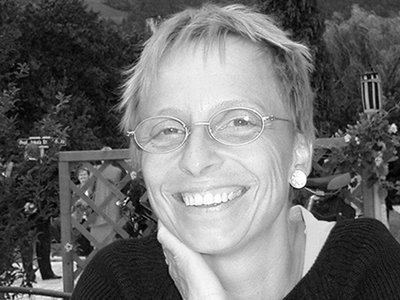- (1975) Jewellery in Europe, V&A, London, UK
- (1983) Inno alla Gioia, Padua, Italy
- (1984) Biennale di Venezia, Ateneo San Basso, Venice, Italy
- (1987–1988) solo exhibition, V&A, London, UK
- (1998) The Ring, Künstlerhaus, Vienna, Austria
- (2006) solo exhibition, Künstlerhaus, Vienna—at the same time the monograph Fritz Maierhofer: Jewellery and More! was published with Arnoldsche
Right now, a retrospective of his jewelry, including new sculptures and tables, is being shown at the Museum of Applied Arts (MAK) in Vienna through March 29, 2015 in conjunction with the Bollmann collection.
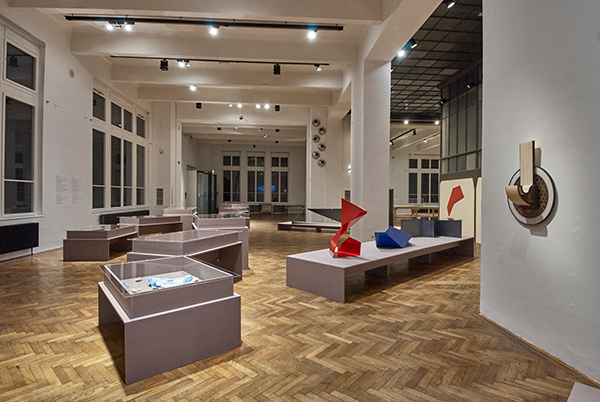
Margit Hart: People who have known you for a long time say that they are always surprised by new aspects of your work, and yet they recognize your personal language. Can you tell us a bit about your approach and how you develop new topics?
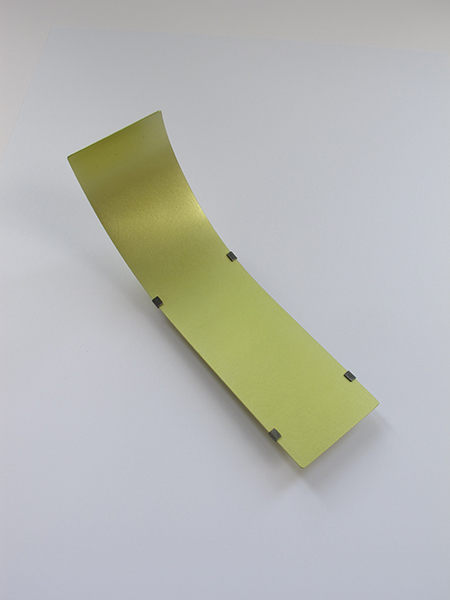 Fritz Maierhofer: First of all, I am indeed very happy that this retrospective at the MAK will also be shown in Ruthin, Wales, and in Padua, Italy. All these places mark important and strong connections in my life. In Vienna I was trained as a goldsmith and worked for many years for A. Heldwein. The UK opened up new horizons for my life as an artist. And my work has been shown in Padua numerous times since 1983.
Fritz Maierhofer: First of all, I am indeed very happy that this retrospective at the MAK will also be shown in Ruthin, Wales, and in Padua, Italy. All these places mark important and strong connections in my life. In Vienna I was trained as a goldsmith and worked for many years for A. Heldwein. The UK opened up new horizons for my life as an artist. And my work has been shown in Padua numerous times since 1983.
For me, jewelry is like a language. It reaches very far back—like language—and leaves its mark on our childhood minds. So these two different topics seem to exist internally, they’re not artificially imported from somewhere outside. I would describe them as feelings that arise over and over again, unconsciously, without thinking, almost like meditation.
Nonetheless, my approach has always been closely connected to my living circumstances. For instance, during my first stay in London, I was fascinated with all the colors in the city, so I started working in acrylics. Back in Austria I moved to the countryside and my work, the “metal drawings,” became quieter.
In 1986 I was honored by the Sir John Cass Foundation with the Senior Visiting Research Fellowship at the City of London Polytechnic (now University). At that time, there was a dramatic program of redeveloping being carried out. The steel-framed buildings and the building sites stimulated my imagination, and a large body of work, the “girders,” came into being. More recently, a three-month stay in Piedmont, Italy, inspired my “mountains” out of paper and watercolors.
When using new materials, I always need time to understand them and to find out their innate qualities. This was the case when I used tin in combination with gold, as well as with steel or aluminum. Then I develop a concept, just for myself or for a planned exhibition. In my early years, I always made lots of drawings before starting to work on the actual pieces. For the “girders” I made cardboard models before deciding which pieces to create. During the process new possibilities might evolve as well; many different aspects are always intertwined. Only the Corian pieces (from 2000 to 2006) and some of my most recent work came into being spontaneously during the process, according to an inner emotion at the moment concerned.
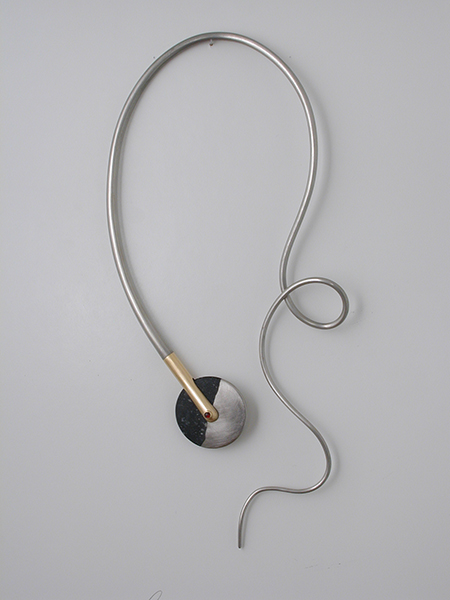 Can you briefly reflect on the development and the reception of contemporary jewelry from the 1960s/1970s to now? What are the major changes?
Can you briefly reflect on the development and the reception of contemporary jewelry from the 1960s/1970s to now? What are the major changes?
Fritz Maierhofer: In my opinion there are too many reproductions, maybe some of them happen unconsciously. This might be typical of our time… And there is also the question of whether it’s still possible to discover anything new. My feeling is that many young artists don’t really have a deeply rooted grounding. A lot of them leave school and start teaching right away… Looking back and reflecting upon things could be worthwhile.
Has the public reception of contemporary jewelry developed in ways that were hoped for 30 or 40 years ago? Why?
Fritz Maierhofer: In the 1970s and 1980s, the reporting in the media was more frequent and much stronger than nowadays. And I miss a certain openness and continuous intellectual development of people interested in wearing jewelry.
Given your teaching experience in England and at summer workshops in Graz, Austria, what would you say is important for young emerging artists to know?
Fritz Maierhofer: I would recommend working for oneself for a certain amount of time after graduating to develop a personal strength, and not exhibiting right away. Things need time to develop and to mature.
When did you break free from your traditional background?
Fritz Maierhofer: In 1966 I decided to finish my master’s diploma and to leave Vienna one year later. As it happened, I came to London and got involved in the arts, and in 1969/1970 I made my first independent pieces. For me, traditional jewelry lacked a direct connection to our lives, to the reality of the 1960s; it didn’t have anything to do with what was going on in other fields of art, like painting, sculpture, or even music and film.
So I wanted to develop something new, something that wasn’t primarily connected to the notion of being precious; so no diamonds, no rubies… Claus Bury, who was in London as well, and I talked a lot about new means of expression, and I discovered acrylic as a perfect material to express my thoughts. Using the technical skills I had acquired in the years prior, I built complex pieces combining acrylic with silver and gold.

What are your sources of inspiration?
Fritz Maierhofer: Traveling, visiting art galleries, discussions with colleagues from the field always inspired me! I liked meeting interesting people and I always cultivated contacts. In the 1970s I traveled to England a lot and I always stopped somewhere in Germany to meet with colleagues such as Friedrich Becker, Hermann Jünger, Jens Rüdiger Lorenzen, or Reinhold Reiling.
After some time abroad, I always felt the need to retreat, to sit down quietly and concentrate on my work.
What is your personal way of proceeding in developing your pieces? How did you develop your personal signature style?
Fritz Maierhofer: It really depends, there are always many different things going on parallel to each other. In the beginning something might not seem of relevance, and then suddenly, looking back, it becomes an important piece. Sometimes you stray from the well-known path, create something totally different, and then you might return to the old path without knowing where it will lead you.
Developing a signature style might even happen imperceptibly. But first of all you have to work in a serious and consistent way.
How did you start your career? Did you go to different galleries? Did you participate in competitions? Or what?
Fritz Maierhofer: Both. I went to a lot of galleries to show my work—at that time there were no jewelry galleries, so I first showed in fine art galleries that were intrigued by this kind of new work.
And there was one important competition for me: In 1972 I won the “Preis des internationalen Schmuckwettbewerbs des Schmuckmuseums Pforzheim,” showing my acrylic and gold/silver pieces. From then on, more people got interested in my work and my name started to get known internationally.
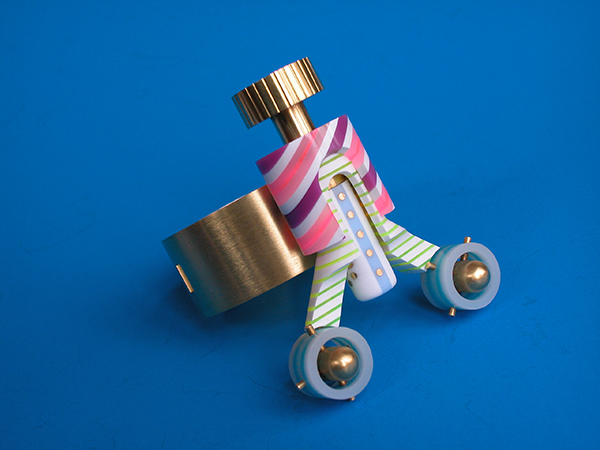
What do you see as important and rewarding when you work in your studio now? Is it different from your early years?
Fritz Maierhofer: I am fulfilling my work, independent of the place I’m living in. I am very stubborn; for me it’s extremely important to do what I want. And also—now even more than in previous years—to not know exactly where I’ll be going, to leave things open…
Thank you.
